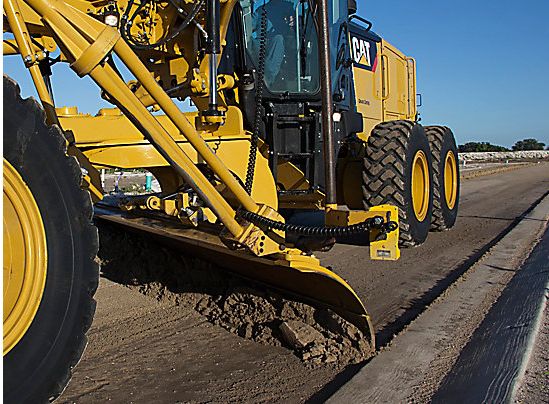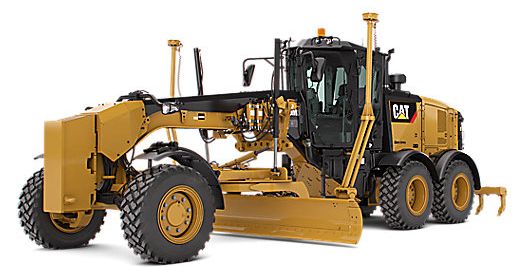The fundamentals of operating any piece of heavy equipment begin with safety. The front end loader has unique characteristics that need to be considered. The main danger with a front end loader is the danger of overturning the machine due to the bucket being in the raised position. Having material in the bucket adds considerable weight and therefore acts as leverage against the machine side to side. This needs to be carefully considered when operating on uneven or rough ground. As an operator you should have a good working knowledge of each individual machine before performing any task at production speed. Each machine is a little different and when you go from operating say; a Caterpillar 938 loader to a Caterpillar 992 loader, the size and handling characteristics are vastly different. Even a tire that has improper pressure can cause the machine to sway from side to side with the bucket raised, possibly leading to the tire to blow out with a load in the bucket resulting in the machine overturning. I cannot stress enough the importance of inspecting the equipment before the shift, mid shift and post shift. An operator needs to know what to look for and report anything out of place to your supervisor and or mechanic. This could save your or life or someone else and prevent very costly repairs to the equipment. Heavy equipment is very expensive to maintain, a large loader or scraper tire can easily cost $ 5,000.00 to replace, and engine can be $20,000.00 – $40,000.00 and this does not even address the down time for the company or you.
The Motorgrader has very unique capabilities, such as slope work that need to be understood before attempting to perform safely. Another present danger with the grader is people on the ground working around the machine, such as a grade checker or stake chaser. The grader, like every piece of equipment has a “blind” spot that the operator and those working around it need to be aware of. Directly behind the machine is a place that the operator cannot see (some of the new Caterpillar M series have a camera to view this area as an option) but one should still view it as a blind spot.
A bulldozer has incredible capabilities such as working on steep slopes or ripping out large boulders that could roll downhill and crush property or people. Many times a bulldozer will be the piece of equipment to “Pioneer” a large steep cut just because of its ability to get there and the mass excavation ability. I have personally seen boulders that were dislodged in this operation roll downhill a long ways and destroy vehicles. Sometime this may be hard to avoid; so there needs to be traffic control to keep vehicles out of the area while this operation is going on. Furthermore I cannot overemphasize that communication is vital between the operator and crewmembers on the ground. Bulldozers are built with a low center of gravity; however you can still turn one over. Another danger is having a larger size rock roll under the uphill side track while side casting on a slope could be enough to turn the machine over, especially if the operator is unaware of it. Solid rock is also very dangerous as the grousers on the tracks cannot get traction; especially if the machine is sideways (it is just like a skate on ice). A large bulldozer has blind spots along the sides and in the rear also. People on the ground should always get the operator to make eye contact with them before attempting to approach the machine.
Scrapers are some of the largest pieces in the field, and possibly have the most important role in constructing something ;( you cannot fine grade something until it is built). Rollovers are the most common safety concern with scrapers. Carrying the “can” too high on a slope or when turning can lead to a rollover due to the weight being carried higher, a load of dirt can easily weigh 50,000 lbs. A Caterpillar 631 G model scraper weighs in at approximately 102.000 lbs empty; combine this with speed, a slick haul road and you have very deadly machine that will not stop in a dime! Right of way should be given to scrapers, especially when they are loaded. They are the true “moneymakers” of the spread.
Track hoes are a very versatile machine that can perform mass excavation, slope work and underground trenching. They have a blind spot directly behind them that the operator and people working around the machine need to be aware of. Another safety issue involves the underground trenching; improper shoring, trench benching, spoils placement and striking buried utilities can lead to equipment damage and or serious injury to the operators and people working in and around the trench. It is a very good idea to have everyone on the crew take the OSHA class for trenching and become a COMPETENT PERSON.
Pneumatic and vibratory rollers main areas of safety concerns are; rollovers and crushing. When operating on a slope with a vibratory sheepsfoot you should never operate parallel to the roadway on a slope steeper than a 6: 1, if it is steeper than that you should roll perpendicular to the roadway. Pneumatic rollers are strictly for flatter terrain, they can become stuck very easily or overturn with a minimal undulation of the grade being prepared.
Off road haul trucks can range from something as small as a 35 ton articulated rock truck to a 240 ton mine haul truck. These trucks are pretty simple to operate, which can lead to carelessness. These trucks have a lot of blind spots. Care should be taken to back these trucks on the driver’s side. An example would be; as you approach the track hoe or loader, head toward to the machine and then turn clockwise before you back up to get loaded, all the while you keep the clear path visible out of your driver side mirror. This enables you to see a spotter on the ground or an operator signaling you where to dump or get loaded. These trucks can be top heavy when loaded, slow down as you enter any sharp turns. The rollover danger is the main concern, also you can “roll” a front tire off of the rim, ruining the tire or possibly leading to a rollover. Another danger is present in hoisting the bed to dump the load; you should be on relatively level ground that is very stable. When you get the bed up with most of the material still in the box, there is a tremendous amount of concentrated weight on the rear wheels. If you hoist the bed and it feels like it is leaning, stop and lower it and move to a more stable spot or have the dozer level the dump. Pre and post trip inspections are very critical with these trucks, with tires in the five to ten thousand dollar range and engines twenty to fifty thousand dollars.
Water trucks and water wagons are another critical piece of the spread. They are top heavy when loaded and have the danger of sloshing water that can contribute to a rollover situation. Another safety issue with dual wheel truck is; getting rocks wedged in between the duals that can ruin tires or come loose when traveling on a roadway. I have seen rocks go right through a mud flap and through the windshield of a vehicle following behind.
On road end dumps, belly dumps and side dumps have their issues also. The aforementioned dangers with dumping the rock trucks holds true with these trucks also, especially the 35- 40 end dump trailers. I have seen several of these go over when attempting to dump on unlevel, unstable ground or with a breeze blowing. Having wet material or even a rock lodged in the front of the box can cause it to tip over. A spotter dumping trucks should never stand where this box could fall. Another danger for these trucks is overhead utility lines, make and check before hoisting the box! If you hit an electrical line while hoisting the box, stop and call for help… do not attempt to exit the truck, you could be electrocuted when you touch the ground if you are in contact with the truck. After you dump make sure the bed goes all the way down and your P.T.O unit is disengaged before moving the truck… I have seen partially lowered boxes strike overpasses and other things. This can at the very least ruin your day and cause significant damage, but also injury or death.
Belly dumps main danger is backing over someone or something. There is usually a dump man on a paving spread and possibly a flagger… make sure you know where they are before you back up. Make eye contact with the dump man also, he operates the dump valve on the trailer as you are moving. He needs to make sure and walk to the side of the trailer and not get his feet under the trailer tires… they can roll right up the back of your leg and kill you in a heartbeat. I have seen more than one person that was backed over by a belly dump… backup alarms are mandatory but people on the ground turn them out after awhile, necessitating that the driver pay close attention and it is preferable to toot his air horn a couple of time before backing up. This holds true for other on road trucks also.
Side dumps are very prone to tipping over while dumping… so much one driver I worked with got to the point of being able to shut the engine off before the tractor tipped over. The reason for them tipping over is that the weight of the load all goes to the side while dumping. Most of the rollovers occur while dumping on the fly. To be on the safe side, stop while dumping and or jackknife the tractor 90 degrees away from the direction of the dump.
Back hoes share some of the same capabilities as the track hoe as well as some others. The underground dangers are the same; the blind spot on a backhoe is in front of the machine while the operator is digging with the boom on the rear, the operator frequently “pushes” the machine forward while digging. You can tell when he is going to do this when he lifts the outriggers and lifts the front bucket. Laborers should stand clear of the boom if you are in a trench and make eye contact with the operator if you need to check something within the reach of the boom. The turning brake features on the back hoes are very handy if you know how and when to use them… however when you are not using them make sure they are latched together. I have seen back hoes turn unexpectedly when these are unlatched… one taking out a outhouse and another time a transport driver rolled one off of a trailer, the only thing hurt those times was pride. Never operate the controls from outside of the machine, it is very easy to be crushed and seriously injured or killed while doing this.
I have personally seen seatbelts save many lives and serious injury, wear them!
This article is not a substitute for a safety program or proper training and supervision. It is for information only.




